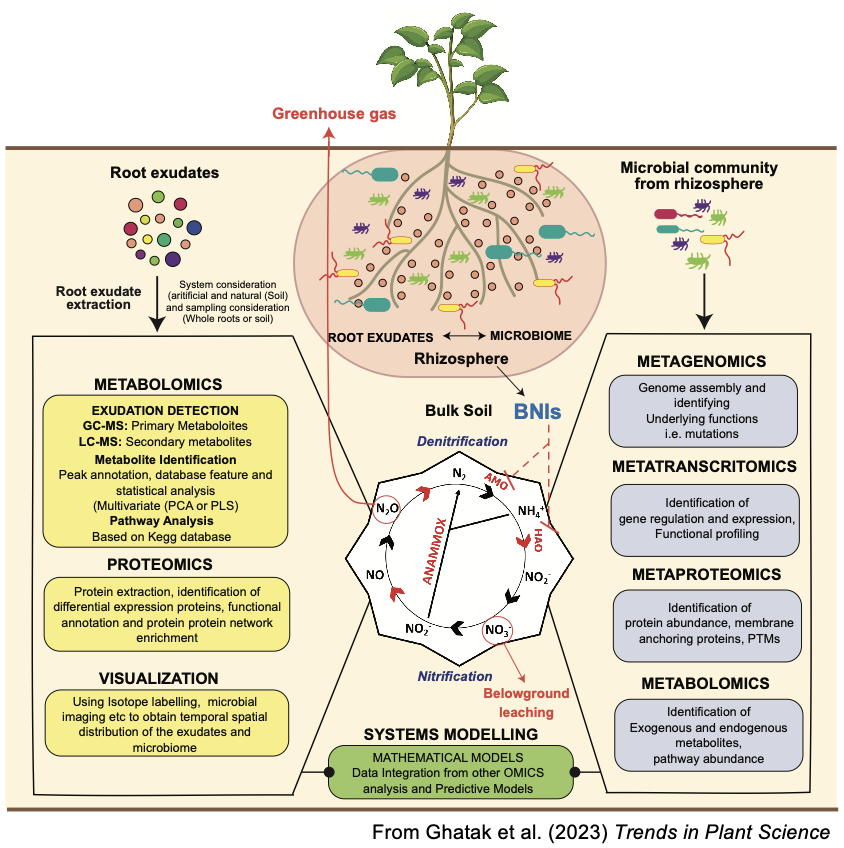PANOMICS Approach Contributes to the Advancement of BNI Research
―Expectations for elucidating the interactions between plant roots and soil microorganisms―
PANOMICS Approach Contributes to the Advancement of BNI Research
― Expectations for elucidating the interactions between plant roots and soil microorganisms ―
|
Main Points
|
Overview
In January 2023, a paper describing the interaction between plants and soil microorganisms in biological nitrification inhibition (BNI) by a research group of JIRCAS and the University of Vienna, Austria, was published in Trends in Plant Science, an international plant science review journal published by Cell Press (with an impact factor of 22.01), one of the most prestigious journals.
In this review article, the authors advocate the use of PANOMICS approach as a new method to search for BNI substances that plants secrete from roots and inhibit nitrification. The PANOMICS approach is a method of comprehensively analyzing various molecules that make up a living organism based on genomic information using metabolomics, proteomics etc., and utilizing the obtained data from a bird's-eye view using mathematical models.
It is estimated that as many as 10 billion soil microorganisms exist per gram of soil in the rhizosphere, which is within a few millimeters of the roots, and they are thought to have various functions. Although there are interactions between plants and soil microorganisms, which are expected to be utilized, plant roots have been considered more difficult to observe and measure than the above-ground area because of their underground existence.
Recent innovations in omics analysis and advances in computational science have made it possible to better understand and control interactions between organisms by extracting key factors for various functions and identifying important pathways. While there are many examples of studies on human-microbe interactions using omics analysis, and it is becoming clear that a complex network of interactions is being formed, there are few studies on plant-soil microbe interactions, especially those in the rhizosphere, and even the methodology is not yet fully established.
This review focuses on BNI which utilizes the interaction between plants and soil microorganisms in the rhizosphere, i.e., BNI substances secreted from plant roots inhibit the activity of soil nitrifying bacteria and delay the nitrification of ammonium in the soil (the pathway of oxidation from ammonia nitrogen to nitrate nitrogen). As a result, is expected to be put into practical use in the future as a technology that can increase crop productivity even with low fertilizer application. Utilizing the PANOMICS approach, which combines multiple omics analyses as a method to search for key BNI substances for interaction by BNI technology, will not only contribute to the advancement of BNI research, but also to the understanding of the interaction between plant roots and soil microorganisms.
JIRCAS pioneers in the development of technology to reduce the environmental impact from agriculture derived from nitrogen fertilizers based on a deep understanding of BNI. A press release entitled World's first successful development of BNI-wheat that shows high productivity with less nitrogen fertilizer was published on August 31, 2021. JIRCAS also presides over the BNI International Consortium, which leads and coordinates international BNI research and is promoting joint research with the University of Vienna, a consortium member, for a deeper understanding of BNI using the PANOMICS approach.
JIRCAS, together with collaborating institutions around the world, is promoting the development of BNI-enhanced crops that reduce greenhouse gas and water pollutant emissions. This will enhance the productivity and sustainability of agriculture and contribute to the promotion of the MeaDRI Strategy on food systems transformation.
Publication
- Authors
- A Ghatak, P Chaturvedi, S Waldherr, GV Subbarao, W Weckwerth
- Title
- PANOMICS at the interface of root-soil microbiome and BNI
- Journal
- Trends in Plant Science
DOI: https://doi.org/10.1016/j.tplants.2022.08.016
For Inquiries
JIRCAS President KOYAMA Osamu
- Program Director
- HAYASHI Keiichi (Environment Program)
- Principal Investigatos
- Guntur V. Subbarao (JIRCAS Crop, Livestock and Environment Division), Wolfram Weckwerth (Vienna Metabolomics Center, University of Vienna)
- Press Coordinator
- OMORI Keisuke (Head, Information and Public Relations Office)
E-mail:koho-jircas@ml.affrc.go.jp



